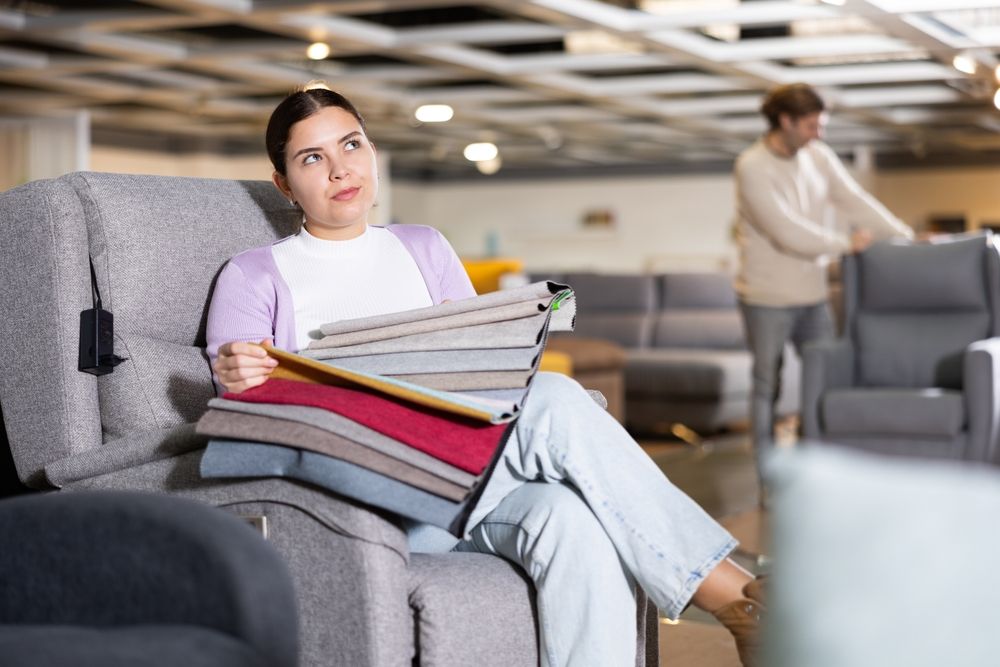A sofa is often the heart of a living room—where you unwind after work, entertain guests, or curl up for movie night. It’s a big investment, so picking the right one isn’t just about size or style. The material you choose will determine how your sofa feels, how it wears over time, how easy it is to clean, and even how well it suits your lifestyle.
With so many upholstery options out there, it can be hard to know which is truly best for your needs. Here’s a practical guide to help you decide.
Consider How You’ll Use Your Sofa
Start by asking yourself some honest questions:
-
Do you have young kids or pets who’ll be on the couch daily?
-
Is your living room a formal space, or a casual hangout zone?
-
Will it be a spot for naps and snacks, or mainly for occasional guests?
-
Do you live in a hot or humid climate, which could make certain fabrics uncomfortable?
The answers will steer you toward materials that can handle your lifestyle.
Natural vs. Synthetic Fabrics
Most sofa materials fall into two broad categories.
Natural fabrics include cotton, linen, wool, leather, and sometimes silk. They’re prized for their comfort and upscale look. However, they can be more prone to staining and fading.
Synthetic fabrics—like polyester, nylon, acrylic, or microfiber—are generally more stain-resistant, durable, and affordable. Many modern synthetics mimic the feel of natural fibers surprisingly well.
Often, you’ll find blends, combining natural fibers with synthetics for a best-of-both-worlds approach.
Popular Sofa Materials and Their Pros & Cons
1. Leather
Pros:
-
Luxurious look that ages beautifully.
-
Easy to wipe clean—great for spills and pet hair.
-
Very durable and long-lasting.
Cons:
-
Can scratch, especially with pets.
-
Can feel cold in winter and sticky in hot climates.
-
Higher upfront cost.
Best for: Households looking for a timeless investment piece, or people with allergies who want something that won’t trap dust.
2. Cotton
Pros:
-
Soft, breathable, and comfortable in all climates.
-
Available in a wide range of colors and patterns.
-
Often affordable.
Cons:
-
Prone to wrinkling and can stain easily.
-
Pure cotton isn’t the most durable over years of heavy use.
Best for: Formal living rooms or low-traffic spaces where you want a cozy, natural feel.
3. Linen
Pros:
-
Light, airy, and elegant with a natural texture.
-
Perfect for a relaxed, coastal, or rustic look.
Cons:
-
Wrinkles easily and can be difficult to clean.
-
Not ideal for everyday, high-traffic seating.
Best for: Aesthetic-focused spaces or second living rooms where it won’t see rough daily use.
4. Velvet
Pros:
-
Gorgeous, plush texture and deep color.
-
Surprisingly durable when made from quality synthetic blends.
Cons:
-
Can show pressure marks and is more prone to attracting pet hair or lint.
-
Needs occasional brushing or steaming.
Best for: Those who want a bold, luxurious statement piece.
5. Microfiber (Polyester or Microsuede)
Pros:
-
Incredibly durable, stain-resistant, and budget-friendly.
-
Easy to clean—most spills bead up, and pet hair brushes off.
Cons:
-
Doesn’t have the same breathable feel as natural fabrics.
-
Can develop static.
Best for: Busy families, pet owners, or anyone needing a low-maintenance option.
6. Chenille
Pros:
-
Very soft with a slightly shimmery, textured finish.
-
Comfortable and inviting.
Cons:
-
Loops can snag, making it less ideal for homes with cats.
-
Might need more careful vacuuming.
Best for: Casual living rooms where comfort is key.
Think About Color and Pattern
Beyond the type of material, your fabric’s color and pattern will affect maintenance and overall vibe.
-
Dark colors and patterns hide stains and wear better.
-
Light colors brighten a room but show dirt more easily.
-
Textures or small-scale patterns can disguise everyday signs of use.
Also consider fading: if your sofa will sit in direct sunlight, some dyes—especially in natural fibers—may fade over time.
Maintenance and Cleaning Needs
Different materials come with different care requirements.
-
Leather needs occasional conditioning to stay supple.
-
Microfiber is usually a breeze—most spills wipe right up with water.
-
Cotton and linen often benefit from professional cleaning or slipcovers that can be removed and washed.
-
Velvet needs careful vacuuming and can require occasional steaming to restore the nap.
If you’re not keen on high-maintenance upholstery, stick to easy-care synthetics or treated fabrics.
Allergen and Pet Considerations
If you or family members have allergies, look for tightly woven fabrics that resist dust and dander. Leather is often recommended for allergy sufferers because it doesn’t trap allergens. Microfiber is another good choice—it’s dense enough to repel dust mites.
For pets, avoid materials with loose weaves or loops (like chenille) that claws can snag. Smooth leather or tightly woven synthetics handle pets best.
Always Try Samples First
Fabric can look completely different in your home than it does in a store. Before making a big purchase:
-
Request swatches and look at them in your room’s natural and artificial light.
-
Touch and stretch the samples—see how they feel and if they wrinkle.
-
Place them next to your wall color and other furniture.
This small step can prevent major regret later.
Budget Considerations
Your choice of fabric can significantly affect the sofa’s price. In general:
-
Leather and high-quality natural fabrics cost the most.
-
Synthetic blends and microfiber are the most budget-friendly.
-
Performance fabrics—designed to resist stains and wear—cost a bit more but can save money over time by extending your sofa’s lifespan.
Decide what balance of upfront cost and long-term durability makes sense for your family.
Choosing the right sofa material isn’t just about what looks good on the showroom floor. It’s about finding a fabric that suits how you live, feels comfortable every day, and holds up to your home’s unique demands.
By weighing your lifestyle, aesthetic preferences, budget, and the practical realities of care and durability, you’ll end up with a sofa that doesn’t just look great—but truly fits your life. After all, this is where you’ll binge-watch shows, host friends, and maybe even sneak a nap. Make sure it’s a choice you’ll love for years to come.


